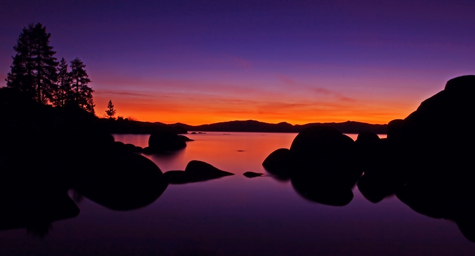
You can usually avoid noise problems by shooting at a low ISO (400 or lower for most cameras), but noise becomes a problem again when using a long exposure (anything longer than one second).
You may be wondering why you would ever use such a long exposure anyway. Well, here are a couple examples:
- To show motion (for waterfalls, streams, etc)
- To smooth out the surface of a lake (like in the photo above of Lake Tahoe)
- Astrophotography (photographing the stars requires long exposures and a wide aperture)
Okay, so how do you battle the noise you’re likely to experience with these long exposures?
Well, most newer digital SLRs have a special noise reduction option for long exposures. This option is usually buried in your camera’s endless menus or list of custom functions, so you might have to dig up your camera’s manual to learn how to enable this feature.
With this feature enabled, your camera will automatically take a second exposure of equal length to the first but without opening the shutter–this second exposure is known as a “dark frame.”
The noise found in this “dark frame” is then subtracted from the original to produce a much less noisy image.
If you enjoyed this article, and would like to read more, please signup for free updates by email or RSS.
 About the Author: Steve Berardi is a naturalist, photographer, computer scientist, and founder of PhotoNaturalist. You can usually find him hiking in the San Gabriel Mountains or the Mojave Desert, both located in the beautiful state of California.
About the Author: Steve Berardi is a naturalist, photographer, computer scientist, and founder of PhotoNaturalist. You can usually find him hiking in the San Gabriel Mountains or the Mojave Desert, both located in the beautiful state of California.
Great article !!! I found the noise reduction for my Canon….it was disabled, so I set it to auto !!! I’ll try it !!!!
thanks a lot Steve!!! superb tip. I was wondering how to eliminate the turbulence in lake…
Thanks Steve, late eve photography is just about my favorite, past sunset the light can be wonderful. Depending on the effect I want, I use 100 ISO and long exposures on a tripod and using a cable release. I’ll check my Canon to see if it has the noise redduction feature, it’s an older 20 D, still working well, I’m due for a new one, undecided between the latest Rebel, 7D or 5D Mark II, great range difference between price, and weight. Full frame is the main reason for wanting the 5D Mark II. I love the lightness and features of the Rebel, and I believe it has a hinged LCD screen. I am an older, small frame woman. Any suggestions? I value your opinion and absolutely enjoy your tutorials, clear and easy to follow. Thank you so much for your generous contribution to making better photographers of the rest of us.
@Nubia – Any of those three cameras (Rebel, 7D, 5DmkII) will be a great upgrade from the 20D. Which one you should get really depends on what kind of stuff you like to photograph. The 7D is excellent for wildlife because of its fast frames per second (it can shoot up to 8 photos per second, versus about 4 on the rebel/5D). But, the 5D is great for landscapes and anything shot at higher ISOs (800 or higher). At ISO 100, I would say the image quality between the three cameras is pretty close (lenses factor a lot more into the image quality than the camera), so I would try to base your decision on what you like to photograph most: if you mostly shoot wildlife, I’d recommend the 7D. But, if you only shoot landscapes, I’d recommend the 5D. If you do a little bit of both, then I’d prob go with the 7D, but get a wider angle lens too (10-20mm).
Thanks Steve, I had not checked your reply here, thank you for the email. The 7D sounds about the best for my needs, (I shoot wildlife also), and it’s not quite as heavy as the 5DmkII.
I am aware a good lens is more important and the one I considered is also quite heavy, (Canon 70-200 f/2.8 IS II USM and a 2x teleconverter), and expensive as well but it’s got the best reviews.
Thanks for your suggestions, they’re most welcomed
Hi Steve,
I went out tonight to capture the sunset over the ocean, Seascape/Landscape is not something I’ve done before, so I know that I have a lot of learning to do in this area. What is captivating me is the awesome reflections at this time of year here in Ireland.
I use a Canon 500D & a tripod, the “noise reduction option for long exposures” is set to auto, the ISO is 100 & I used various exposure’s. When I uploaded my photos they were all grainy, is there something else I need to be aware of with any of the camera’s functions ?
I have done macro for so long that it actually feels strange to see the vastness of the landscape through the viewfinder lol
Thank you for responding to my previous comments, fantastic site.
It;s ok Steve I know what the problem was, I was on sand, it was the movement lol, thanks
Thanks Steve! great article ! A hug from Brazil!